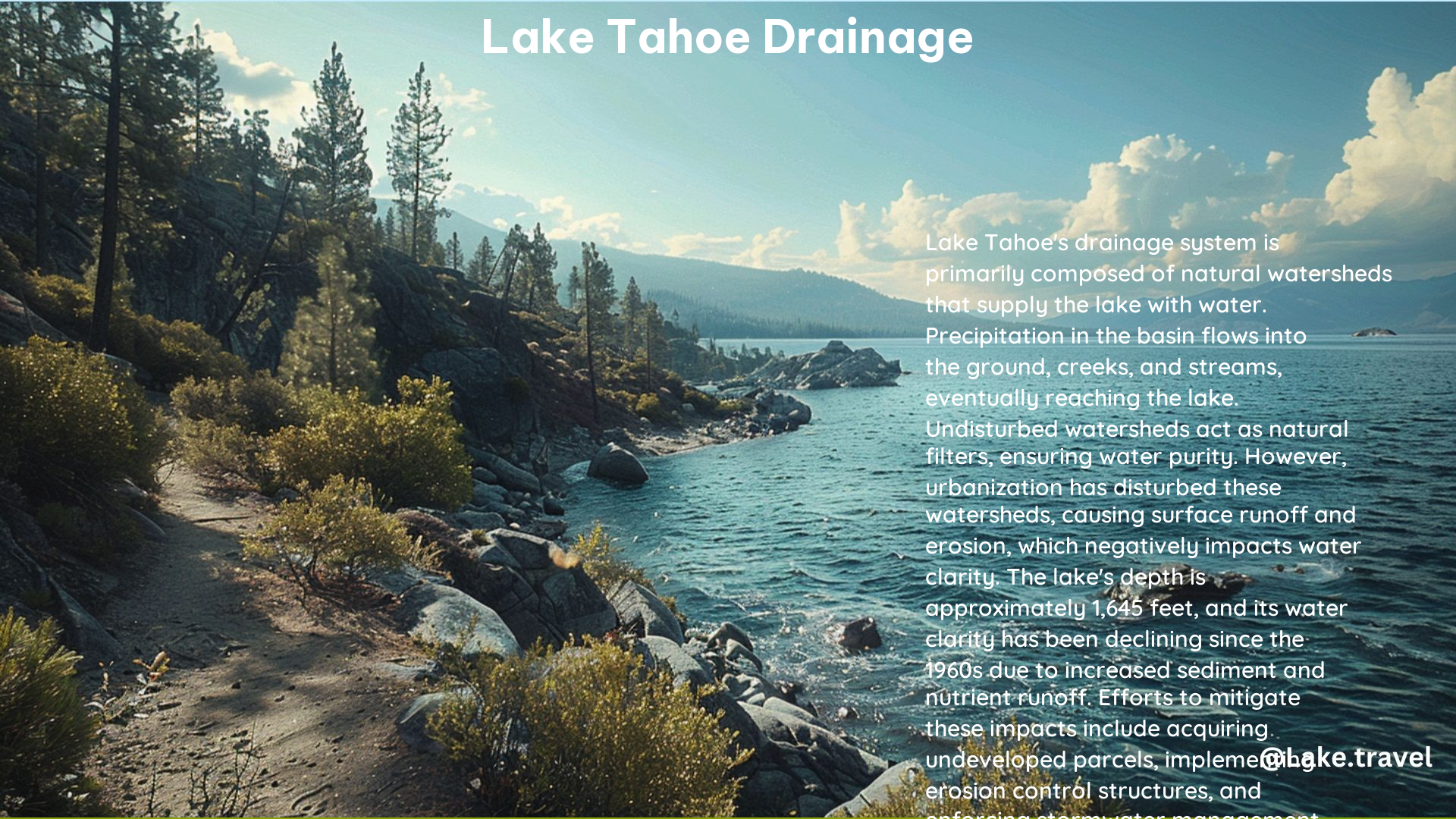Lake Tahoe’s drainage system is a critical component in maintaining the lake’s renowned water quality and clarity. As a natural wonder, Lake Tahoe’s pristine waters have long been a source of fascination and enjoyment for visitors and locals alike. However, the watersheds surrounding the lake have faced significant challenges due to urbanization and development, necessitating the implementation of various best management practices (BMPs) to mitigate the negative impacts on the lake’s drainage system.
Understanding Lake Tahoe’s Drainage System
Lake Tahoe’s drainage system is designed to supply the lake with water from precipitation that falls within the basin. In undisturbed areas, over 95% of rain and snowmelt percolates into the ground, where it is filtered by soil, plants, and organisms, resulting in very pure water that eventually reaches the lake. This natural hydrologic function is crucial for maintaining the lake’s exceptional water quality.
The Impact of Urbanization and Development

The watersheds of Lake Tahoe have been significantly impacted by urbanization and development, leading to a decline in water quality. Pavement, rooftops, and other impervious surfaces in developed areas repel over 90% of precipitation, causing surface runoff. This runoff concentrates in ditches and gullies, leading to soil erosion and the transport of sediments, nitrogen, and phosphorus into streams and eventually into Lake Tahoe.
Best Management Practices (BMPs) for Lake Tahoe Drainage
To mitigate the negative impacts of development on Lake Tahoe’s watersheds, several best management practices (BMPs) have been implemented:
Acquiring Undeveloped Urban Parcels
The acquisition of environmentally sensitive parcels has helped prevent the increase of impervious surfaces and preserved the natural hydrologic function of undisturbed forest areas.
Stormwater Management
The City of South Lake Tahoe’s Stormwater Management Program works to control and reduce the discharge of pollutants from private lands and city streets into local surface waters. This includes prohibiting non-stormwater discharges and implementing pollutant load reduction programs.
Erosion Control Structures
The construction of erosion control structures helps slow the flow of water and reduce sediment transport into streams and the lake.
Public Awareness
Educational efforts aim to increase public awareness about the effects of urban runoff on surface waters and encourage behavior to reduce pollutant discharges.
Implementation and Costs
The implementation of these BMPs involves significant costs and efforts from various stakeholders:
- Costs: The costs of acquiring and managing undeveloped parcels, constructing erosion control structures, and implementing stormwater management programs are substantial, ranging from $1.5 million to $5.5 million for projects outlined in the 2008 Drainage Master Plan.
- Timings: The implementation of BMPs is an ongoing process, with projects and initiatives spanning multiple years. For instance, the pollutant load reduction program aims to reduce fine sediment particles by 10% from 2004 to 2016.
- Directory and Hours: The City of South Lake Tahoe’s Stormwater Program can be contacted at (530) 544-1910 for reporting illicit discharges and obtaining information on stormwater management practices.
- Rates and Value: The value of preserving Lake Tahoe’s water quality and clarity is significant, with the lake supporting a multi-billion-dollar tourism industry. The implementation of BMPs helps maintain this value by protecting the lake’s ecosystem and aesthetic appeal.
Conclusion
Lake Tahoe’s drainage system is a vital component in maintaining the lake’s renowned water quality and clarity. The implementation of best management practices (BMPs) to mitigate the impacts of urbanization and development is an ongoing effort that requires significant investment and collaboration from various stakeholders. By preserving the natural hydrologic function of the lake’s watersheds, these BMPs play a crucial role in safeguarding the beauty and ecological integrity of this natural wonder for generations to come.
References
- USDA Forest Service. (n.d.). Lake Tahoe Basin Mgt Unit – Resource Management. Retrieved from https://www.fs.usda.gov/detail/ltbmu/landmanagement/resourcemanagement/?cid=fsm9_046520
- YouTube. (2023, March 7). The water in Lake Tahoe has ‘flipped!’ Researchers say. Retrieved from https://www.youtube.com/watch?v=P2H9y5hk16Q
- City of South Lake Tahoe. (n.d.). Stormwater Program. Retrieved from https://www.cityofslt.us/342/Stormwater-Program
